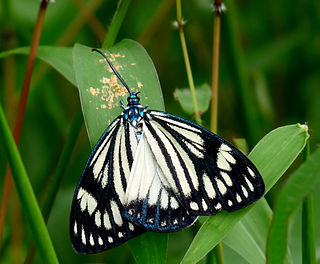
Lepidoptera is an order of insects that includes butterflies and moths. About 180,000 species of the Lepidoptera are described, in 126 families and 46 superfamilies, 10 percent of the total described species of living organisms. It is one of the most widespread and widely recognizable insect orders in the world. The Lepidoptera show many variations of the basic body structure that have evolved to gain advantages in lifestyle and distribution. Recent estimates suggest the order may have more species than earlier thought, and is among the four most speciose orders, along with the Hymenoptera, Diptera, and Coleoptera.

Danainae is a subfamily of the family Nymphalidae, the brush-footed butterflies. It includes the Daniadae, or milkweed butterflies, who lay their eggs on various milkweeds on which their larvae (caterpillars) feed, as well as the clearwing butterflies (Ithomiini), and the tellervini.

The Zygaenidae moths are a family of Lepidoptera. The majority of zygaenids are tropical, but they are nevertheless quite well represented in temperate regions. Some of the 1000 or so species are commonly known as burnet or forester moths, often qualified by the number of spots, although other families also have 'foresters'. They are also sometimes called smoky moths.

The Tortricidae are a family of moths, commonly known as tortrix moths or leafroller moths, in the order Lepidoptera. This large family has over 11,000 species described, and is the sole member of the superfamily Tortricoidea, although the genus Heliocosma is sometimes placed within this superfamily. Many of these are economically important pests. Olethreutidae is a junior synonym. The typical resting posture is with the wings folded back, producing a rather rounded profile.

The Pyralidae, commonly called pyralid moths, snout moths or grass moths, are a family of Lepidoptera in the ditrysian superfamily Pyraloidea. In many classifications, the grass moths (Crambidae) are included in the Pyralidae as a subfamily, making the combined group one of the largest families in the Lepidoptera. The latest review by Eugene G. Munroe and Maria Alma Solis retain the Crambidae as a full family of Pyraloidea.

The Hepialidae are a family of insects in the lepidopteran order. Moths of this family are often referred to as swift moths or ghost moths.

The Pyraloidea are a moth superfamily containing about 16,000 described species worldwide, and probably at least as many more remain to be described. They are generally fairly small moths, and as such, they have been traditionally associated with the paraphyletic Microlepidoptera.
Palaephatoidea is a superfamily of insects in the order Lepidoptera with a single family, Palaephatidae with seven known genera. These "Gondwanaland moths" exhibit a disjunct distribution occurring mainly in South America, with four species in eastern Australia and Tasmania and one in South Africa. The larvae spin together leaves of Proteaceae (Ptyssoptera) or Verbenaceae (Azaleodes) . Palaephatoidea, a typical monotrysian group, is one two main candidates as the sister group of most of the Lepidoptera, the Ditrysia.
Cyclotorna is a genus of moths, the sole one of family Cyclotornidae, with five recognized species, all endemic to Australia. This family and the closely related Epipyropidae are unique among the Lepidoptera in that the larvae are ectoparasites, the hosts in this case typically being leafhoppers, sometimes scale insects. The larvae of cyclotornids, however, leave the hemipteran host and become predatory on the brood in ant nests, apparently using chemical cues to induce the ants to carry the larvae into the ant nest.

Spilomelinae is a very species-rich subfamily of the lepidopteran family Crambidae, the crambid snout moths. With 4,132 described species in 340 genera worldwide, it is the most speciose group among pyraloids.
Agathiphaga is a genus of moths, known as kauri moths. It is the only living in the family Agathiphagidae. This caddisfly-like lineage of primitive moths was first reported by Lionel Jack Dumbleton in 1952, as a new genus of Micropterigidae.

Conogethes is a genus of moths in the subfamily Spilomelinae of the family Crambidae. The currently 17 recognized species are distributed in the Indomalayan and Australasian realm.

Abantiades latipennis, known as the Pindi moth, is a species of moth in the family Hepialidae. It may also be referred to as a swift moth or a ghost moth, as this is a common name associated with Hepialidae. Endemic to Australia and identified in 1932, it is most populous in temperate rainforest where eucalypti are prevalent, as the larvae feed primarily on the roots of these trees. Females lay eggs during flight in a scattering fashion. The larvae live for over eighteen months underground, while adult moths survive for approximately one week, as they have no mouthparts with which to feed. The moths are preyed upon by a number of predators, including bats and owls. Brown in colour overall, males are paler and the identifying silver bars of the male's wings are more prominent than those of the female's, with dark margins. Male adults are generally smaller.

Herpetogramma licarsisalis, the grass webworm or pale sod-webworm, is a moth in the subfamily Spilomelinae of the family Crambidae.

Conogethes punctiferalis, the durian fruit borer or yellow peach moth, is a moth of the family Crambidae.
Dioryctria rubella, the pine shoot moth, is a species of snout moth in the genus Dioryctria. It was described by George Hampson in 1891 and is known from south-east Asia, including China and the Philippines.
Conogethes ersealis is a moth in the family Crambidae. It was described by Francis Walker in 1859. It is found in Australia, where it has been recorded from Queensland.
Conogethes semifascialis is a moth in the family Crambidae. It was described by Francis Walker in 1866. It is found in India and Australia, where it has been recorded from New South Wales and Queensland.











